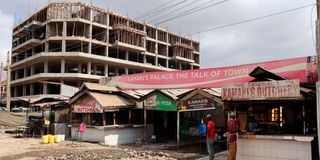The changing face of Kamakis, Nairobi’s ‘nyama choma’ belt

A business centre under construction next to Kamakis butchery.
Tuesday 6pm, Kamakis Palace – the city’s nyama choma joint – on the Eastern Bypass.
There are just two vehicles parked out and a handful of customers inside having meat. Most tables are vacant.
Across the road is another joint, also serving Kenya’s “national dish” and drinks.
Despite being a work day, the parking lot at this joint has about 25 vehicles, with more than half customer occupancy inside.
So, why the disparity, given that the first business is the original Kamakis, a name that is now synonymous with this area?
This question can be answered by going back in time to the beginning of the last decade.
Opened in 2008 as a small butchery, Kamakis would grow to a booming meat and liquor centre two years later.
Other investors saw the potential in that line of trade. By the end of 2014, there are more than 15 similar clubs in the area.
Business boomed and residential buildings started popping up. Back then, the land was undeveloped and full of sisal shrubs. But in the shifting phases of urban development, it was just the beginning.
We are joined by Anthony Maina alias “doctor”.
Kamakis Palace
He currently runs Kamakis Palace, having leased the business from the original owner.
Maina says he returned to the area in 2015 and started out as an employee roasting meat.
“The owner wanted to leave in 2017, and instead of closing shop, he chose to lease it,” says Maina.
“Having worked here for two years, I decided to take over. I had hoped to reap big too.”
He adds that for the next three years everything went well. But there was a steady fall in the number of customers frequenting his place.
Maina says it was the time more modern clubs were being established in the area.
Population was also growing as families looking for less congested residential neighbourhoods settle around.
Most of the households were middle class.
Then the pandemic struck. The business took a break when the government ordered eateries, churches, mosques and other public places shut.
When the economy finally started re-opening, there were high hopes of recovery.
But during the long lockdown, there was another development in Kamakis – business centres started cropping up.
“It started with one club, then two, three and so on,” Maina says.
“Structures were being demolished. New and modern highrise building were being put up in their place.
With the modern structures came new businesses. Most dealt with construction and interior design materials.
Better financed clubs
“That, coupled with the big, modern and better financed clubs, was the beginning of our woes,” he says.
And the future for Maina does not look too rosy. A modern building is being put up right next to his business.
The owner of the land sold it. A business centre is now being put up, with construction beginning at dawn and ending late in the evening.
Miriam Njeri and Billy Ng’ang’a, both residents of the area for more than five years, recount the changes experienced in Kamakis. The area has experienced exponential growth from 2020.
It is a two-kilometre stretch from Thika superhighway to the original club the area is named after.
On this stretch are many businesses – three supermarkets, six petrol stations four banks , cafés and several eateries, including two Art Café outlets, KFC, Galitos, Chicken/Pizza Inn and Jajamelo pizza.
There is also an Equity Afia centre. Aga Khan University and Ruai Family hospitals are further kilometre away.
The area has also attracted private schools, major hardware stores, real estate firms, furniture and electronics outlets, beauty parlours and barbershops, and a myriad other businesses – all bathing in the good fortunes of Kamakis.
Douglas Irungu, the sales manager of Mwanchu Empire Investments – a real estate company based in the area – attributes the fast growth to population increase.
“Apart from people looking to live in less congested urban areas, this whole are is strategically positioned. From here you have easy access to Nairobi, Kiambu, Kitengela and Thika,” Irungu tells the Sunday Nation.
Eastern Bypass
He adds the recent expansion of the Eastern Bypass and the proximity to Tatu and Northlands cities have made the place very attractive to investors and middle class families.
“Just five years ago, an eighth acre plot near the highway was going for about Sh5 million. Those on the third row from the tarmac moving inwards started at Sh1.5 million,” he says.
“As we speak, the prices have more than doubled. The same sizes of land are now going for at least Sh11 million and Sh4 million, respectively.”
Irungu believes say the trend is bound to continue. He says the place will have changed completely in five years.
“Kamakis is becoming a town. The old clubs and entertainment joints will eventually be driven out if they do not move with the times. The people who have shifted to Kamakis are looking for class and modern amenities. There is also need for more diverse services, apart from entertainment. Many investors are capitalising on that,” Irungu says.
He adds that Kamakis has even overtaken Ruiru town in terms of new developments and investor attraction. By all accounts, Irungu’s sentiments are true.
The air is filled with the roaring of machines as groups of men and women toil in the heat to put up buildings on the highway.
A spotcheck behind these buildings as you move towards the residential areas reveals similar activities, perhaps even on a larger scale.
Apartments are coming up by the day, marking the changing face of Kamakis.





